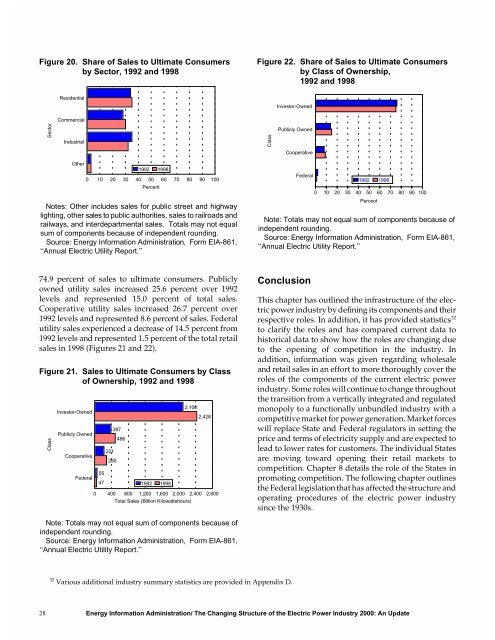The Changing Structure of the Electric Power Industry 2000: An ... - EIA
The Changing Structure of the Electric Power Industry 2000: An ... - EIA
The Changing Structure of the Electric Power Industry 2000: An ... - EIA
You also want an ePaper? Increase the reach of your titles
YUMPU automatically turns print PDFs into web optimized ePapers that Google loves.
Figure 20. Share <strong>of</strong> Sales to Ultimate Consumers<br />
by Sector, 1992 and 1998<br />
28<br />
Sector<br />
Residential<br />
Commercial<br />
Industrial<br />
O<strong>the</strong>r<br />
1992 1998<br />
0 10 20 30 40 50<br />
Percent<br />
60 70 80 90 100<br />
Notes: O<strong>the</strong>r includes sales for public street and highway<br />
lighting, o<strong>the</strong>r sales to public authorities, sales to railroads and<br />
railways, and interdepartmental sales. Totals may not equal<br />
sum <strong>of</strong> components because <strong>of</strong> independent rounding.<br />
Source: Energy Information Administration, Form <strong>EIA</strong>-861,<br />
“<strong>An</strong>nual <strong>Electric</strong> Utility Report.”<br />
74.9 percent <strong>of</strong> sales to ultimate consumers. Publicly<br />
owned utility sales increased 25.6 percent over 1992<br />
levels and represented 15.0 percent <strong>of</strong> total sales.<br />
Cooperative utility sales increased 26.7 percent over<br />
1992 levels and represented 8.6 percent <strong>of</strong> sales. Federal<br />
utility sales experienced a decrease <strong>of</strong> 14.5 percent from<br />
1992 levels and represented 1.5 percent <strong>of</strong> <strong>the</strong> total retail<br />
sales in 1998 (Figures 21 and 22).<br />
Figure 21. Sales to Ultimate Consumers by Class<br />
<strong>of</strong> Ownership, 1992 and 1998<br />
Class<br />
Investor-Owned<br />
Publicly Owned<br />
Cooperative<br />
Federal<br />
55<br />
47<br />
221<br />
280<br />
387<br />
486<br />
1992 1998<br />
2,100<br />
2,428<br />
0 400 800 1,200 1,600 2,000 2,400 2,800<br />
Total Sales (Billion Kilowattshours)<br />
Note: Totals may not equal sum <strong>of</strong> components because <strong>of</strong><br />
independent rounding.<br />
Source: Energy Information Administration, Form <strong>EIA</strong>-861,<br />
“<strong>An</strong>nual <strong>Electric</strong> Utility Report.”<br />
32 Various additional industry summary statistics are provided in Appendix D.<br />
Figure 22. Share <strong>of</strong> Sales to Ultimate Consumers<br />
by Class <strong>of</strong> Ownership,<br />
1992 and 1998<br />
Investor-Owned<br />
Publicly Owned<br />
Cooperative<br />
Federal<br />
Energy Information Administration/ <strong>The</strong> <strong>Changing</strong> <strong>Structure</strong> <strong>of</strong> <strong>the</strong> <strong>Electric</strong> <strong>Power</strong> <strong>Industry</strong> <strong>2000</strong>: <strong>An</strong> Update<br />
Class<br />
1992 1998<br />
0 10 20 30 40 50 60 70 80 90 100<br />
Percent<br />
Note: Totals may not equal sum <strong>of</strong> components because <strong>of</strong><br />
independent rounding.<br />
Source: Energy Information Administration, Form <strong>EIA</strong>-861,<br />
“<strong>An</strong>nual <strong>Electric</strong> Utility Report.”<br />
Conclusion<br />
This chapter has outlined <strong>the</strong> infrastructure <strong>of</strong> <strong>the</strong> electric<br />
power industry by defining its components and <strong>the</strong>ir<br />
respective roles. In addition, it has provided statistics 32<br />
to clarify <strong>the</strong> roles and has compared current data to<br />
historical data to show how <strong>the</strong> roles are changing due<br />
to <strong>the</strong> opening <strong>of</strong> competition in <strong>the</strong> industry. In<br />
addition, information was given regarding wholesale<br />
and retail sales in an effort to more thoroughly cover <strong>the</strong><br />
roles <strong>of</strong> <strong>the</strong> components <strong>of</strong> <strong>the</strong> current electric power<br />
industry. Some roles will continue to change throughout<br />
<strong>the</strong> transition from a vertically integrated and regulated<br />
monopoly to a functionally unbundled industry with a<br />
competitive market for power generation. Market forces<br />
will replace State and Federal regulators in setting <strong>the</strong><br />
price and terms <strong>of</strong> electricity supply and are expected to<br />
lead to lower rates for customers. <strong>The</strong> individual States<br />
are moving toward opening <strong>the</strong>ir retail markets to<br />
competition. Chapter 8 details <strong>the</strong> role <strong>of</strong> <strong>the</strong> States in<br />
promoting competition. <strong>The</strong> following chapter outlines<br />
<strong>the</strong> Federal legislation that has affected <strong>the</strong> structure and<br />
operating procedures <strong>of</strong> <strong>the</strong> electric power industry<br />
since <strong>the</strong> 1930s.

















